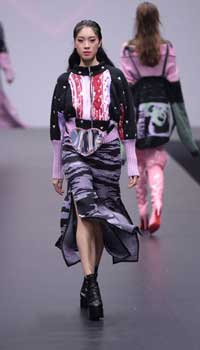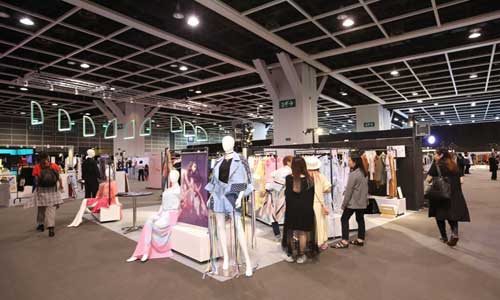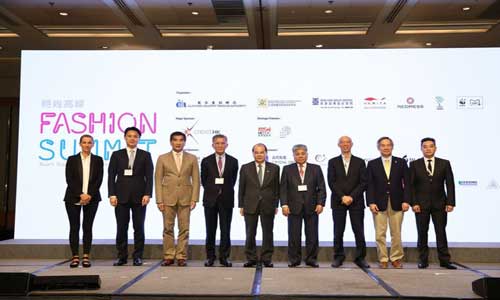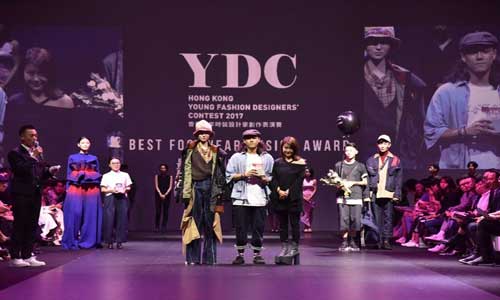FW
The four-day fashion extravaganza, Centrestage, organised by the Hong Kong Trade Development Council (HKTDC), concluded successfully on September 9. It featured more than 210 fashion brands from 22 countries and regions, showcasing latest brands and designer collections. The show attracted 8,500 buyers from 73 countries and regions. Buyers from Thailand, Vietnam, Japan, Singapore and Indonesia increased significantly, and Asian buyers accounted for nearly 40 per cent of the total buyer attendance.
Benjamin Chau, Deputy Executive Director, HKTDC, points out “Centrestage is an ideal promotion and launch platform for Asian fashion brands and designers. In its sophomore edition, Centrestage continued to be a focus of attention for Asia's fashion industry. The event attracted many international fashion brands and buyers, particularly those keen on developing Asian markets. Many up-and-coming local designers also staged fashion shows during the event to showcase Hong Kong's creative designs to buyers and media from around the world.”
A great knowledge sharing platform
A number of master sharing sessions were held during Centrestage. At one of the sessions, Jean Colin, VP- global expansion, fashion division, Samsung C&T Corporation, which represents the Korean brand JUUN. J, analysed the brand's rise to global fashion prominence. Colin said Juun. J realised his dream of establishing his own brand by partnering with Samsung C&T. The company put together a team to help the brand find its market position, and supported Juun. J to join overseas Fashion Week events, she said.
A perfect launch platform
First-time exhibitor Hausie Showroom, a newly established fashion Hong Kong-based company that represents more than 20 international brands was among the exhibitors. Vivian Pang-Williams, Founder, Hausie Showroom, says in their debut participation, they wanted to showcase a variety of fashion collections, jewellery and bags for over 17 brands they exclusively distribute. The company received positive feedback and found about 20 potential customers from different markets, including Galeries Lafayette from France, Aishti Group from Lebanon, and multi-brand stores from the Chinese mainland.
Hong Kong brand ASTRA Tailoring also launched a new menswear label at Centrestage. Design director Ayumi Kwan and partner Angus Tsui said the label’s zero-waste design and emphasis on sustainability attracted buyers from the Chinese mainland, Singapore, Thailand and Japan. Of those enquiring about their products, about five to 10 were serious buyers, with some fabric suppliers also approaching them to explore cooperation.
Hong Kong's fashion in the spotlight
Nicholas Chong, CEO, fashion retail chain YFS, which operates 138 stores in Malaysia, said the company has already identified several Hong Kong designer brands for cooperation. They include: fashion jewellery by CIAO and casual wear for ladies by FromClothingOf. Menswear collections by Hong Kong designer Angus Tsui are also appealing. Chog will explore collaboration to create a new menswear series for the HK$1,000-HK$4,000 retail price market.
Buyers found a great deal of business at the show. Buyer Catherine Coppin was willing to place order with Ffixxed Studios after witnessing its unique collection. Other potential brands such as Zero Design and Garance from Korea, and Kevin Ho, House Of V And Loom Loop from Hong Kong were also worth exploring business.
Henry Pang, buyer of Halo Designer Chic from the Chinese mainland, found some suitable Hong Kong designs at Centrestage. One of the brands was Methodology who plan to show their new 2018 spring/summer designs to Pan. The potential order is estimated between Rmb10,000 to Rmb30,000. Talks are underway with another Hong Kong brand, Anveglosa, for new fur designs for fall/winter 2018.
Cautious optimism in the air
The HKTDC commissioned an independent research agency to conduct on-site surveys during CENTRESTAGE interviewing more than 270 exhibitors and buyers to gauge their view on the outlook for the fashion industry and upcoming product trends. The survey found the industry is cautiously optimistic about sales in the coming year. More than half the respondents expect overall sales to remain steady, while about 40 per cent expect overall sales to grow. Half the respondents expect production costs or sourcing costs to stay unchanged. While nearly half of industry players surveyed expect sourcing price/production cost increases, more than 60 per cent of the respondents said they would not raise unit or retail prices, reflecting a general tendency in the industry to not transfer increased costs to customers.
In terms of markets, more than 80 per cent of respondents consider Hong Kong, Korea and Taiwan to have the best growth prospects among traditional markets in forthcoming two years, while 75 per cent respondents see Chinese mainland as the most promising emerging market. More than 40 per cent respondents favour Eastern Europe and ASEAN markets.
As for product trends in coming year, 70 per cent respondents expect womenswear to be most popular, followed by casual wear and fashion jewellery. Limited-edition collections, brand licensing products and brand crossover promotion were identified as the most prevalent product development strategies in the coming year.
In terms of sales channels, more than 70 per cent said they are engaged in e-tailing, a significant increase from previous year, which saw only over half of the respondents reporting they are involved in such business - an indication that the fashion industry is increasingly serious about e-commerce. On average, online sales account for nearly 20 per cent of the total sales revenue. The top product types sold through e-tailing are womenswear, casual wear and menswear.

On the last day of CENTRESTAGE, the organisers hosted an awards ceremony for the 17th Footwear Design Competition Hong Kong and a product parade of the winning entries. Recognising creative designers in the footwear industry, the competition was co-organised by the Federation of Hong Kong Footwear Ltd (FFHK) and the Hong Kong Trade Development Council (HKTDC). Guests included: Bernard Chan, Under Secretary for Commerce and Economic Development; Frank Leung, Chairman, Federation of Hong Kong Footwear Ltd; Mandy Tang, President, Federation of Hong Kong Footwear Ltd; Selina Chow, Permanent Honourary Advisor of the Hong Kong Footwear Design Competition; Felix Chung, Peter Shiu, Wong Ting-kwong, members of the Hong Kong Legislative Council,and Stephen Liang, Assistant Executive Director of the HKTDC.
Recognising talent
An annual signature event for the industry, the Footwear Design Competition Hong Kong is recognised as the cradle for nurturing and discovering new footwear- design talent needed to sustain future development of the industry. About 70 pieces were shortlisted from nearly 800 inspiring entries received this year, by a judging panel comprised of professionals from related fields. Among them were fashion designers and image consultants, such as Henry Lau, Mountain Yam, Polly Ho, and Christina Dean, founder of the environmental NGO Redress, as well as representatives from the HKTDC, design institutes and industry elites.
Entries competed in six categories: Ladies' Shoes, Ladies’ Boots, Handbag, Children’s Shoes, Men's Shoes as well as the Design & Make Collection DIY – Green Footprints Creation, the latter of which is a new category to promote environmental living. Gold, Silver and Bronze award winners were named in each category, along with prizes awarded to a Belle Overall Champion and a Best Design Award, voted by the public via the FFHK’s Facebook page.
Winning entries
The entry ‘Infinity’ was named Belle Overall Champion, Gold Award in the Ladies’ Shoes category and Best Design Award. Motivated by the environment problem of coral bleaching, designer Joanne Li Wai-ting was inspired to use 3D printing technology in her creation. She used a white-colour theme to symbolise dying coral reefs, in a bid to raise public awareness about marine pollution. Designer Chan Ka-ling, Chan Pui-lam and Lam Wing-yee each received two awards for their exceptional designs. All the shortlisted and winning works were on display during the event.
Technical textiles are the new buzz in Indian textile industry and among emerging and inventive industries in India. Technical textiles offer several advantages in their functional aspects for improving health and safety, cost effectiveness, and durability and strength of textile material. In India, this sector is in its nascent stages while globally it’s a multi-million dollar industry. A large number of technical textile products are consumed by different industries like automotive, healthcare, infrastructure, oil and petroleum, among others.
Indian companies have started producing technical textiles for the international market. Though at a nascent stage, technical textile production in India with the right investment and exposure will definitely compete with international production.
The technical textile industry also has about nine per cent of the world’s total consumption manufactured in India. Indian companies have been introducing several new developments in textile technology. Indian companies are developing products using meta aramid, a textile produced in India which is made from a blend of materials which are environment friendly, lightweight and perform better than asbestos.
These meta aramid products can replace the carcinogenic asbestos in the Indian industry which was claiming the lives of people using them.
GST is expected to increase prices of handloom products by 7.7 per cent. One reason is weight of products in the clothing consumption basket are different due to fiber, make, quality etc. So, a shift of consumers away from handloom products is expected. GST is not revenue-neutral for handloom products. It will change the structure of production and market relations. The rise in cost of handloom products will make them less competitive in retail markets.
GST will increase prices of cotton textiles over synthetics. As a result, blending of synthetic fibers with cotton fibers will gain traction. There is likely to be a huge impact of GST on the fiber mix in the Indian textile industry.
GST is likely to depress natural fiber production and increase man-made fiber production. Organic cotton and organic fiber production supply chains would be stressed. There is no clarity on the classification of handloom products as on date under GST.
GST will impact business strategies of investors, master weavers, cooperatives, retailers and suppliers. Handloom market places, including exhibitions, will have to make necessary changes to handle the new requirements emerging due to GST. The handloom sector is the second largest rural employment provider next to agriculture.
Around 22,900 professional buyers from over 50 countries visited CPM Moscow held from August 30 to September 2. This is an increase of 7.42 per cent over previous year. The show also saw the participation of 1,300 brands, an increase of 31 per cent over the previous year, and 700 exhibitors from 27 countries..
Successful elements of the edition included a top buyer lounge, a fashion show and a fashion contest. A particular visitor magnet, especially for international brands and their representatives, was the CPM Fashion Night with celebrity representatives from Russian TV, Eastern European social media stars, influencers, the media and VIPs.
With segments like lingerie and swimwear, CPM has been an exciting pulsating platform for European, Far Eastern and Russian exhibitors for almost 15 years now. It is a firm foundation for successful business and sustainable brand launches. Country pavilions of Germany, Italy, Spain, France and Turkey offered exhibitors interesting opportunities.
Established, professional and topical industry forums also contributed to the increasing numbers. Professional buyers enjoyed substantiated, trendsetting presentations, forums and panels of an international standard as part of the high-profile Russia Fashion Retail Forum. The forum informed about developments regarding clothing exports to Russia and gave insights into the current situation of the Russian clothing market.
Rwanda Development Board (RDB) has signed a memorandum of understanding (MoU) with Huajian Group, a Chinese business and investment company specialising in shoe manufacturing. Huajian Group is owned by Zhang Huarong and it specializes in production of high- and middle-end women’s shoes with three production bases, including one in Ethiopia. The agreement will see the company establish a factory that will be producing shoes, clothes, bags as well as electronic equipment.
Zhang Huarong has invested in Ethiopia and now produce shoes worth over $30 million. His success has shown him that Africa is a place where you can make high quality exports for products consumed by markets like in the US, says Clare Akamanzi, the RDB chief executive.
Zhang says, his company’s plans to invest over $1 billion for the next 10 years and create over 20,000 jobs. Zhang expressed confidence about his future investment in Rwanda as he believes the country’s development strategy is quite similar to China’s. Zhang is interested in investing in electronics and IT development, creating jobs and boosting Made-in-Rwanda exports. He also plans to produce cell phones, air conditioners and computers.
According to RDB officials, the Government has already availed land at the Kigali Special Economic Zone and they believe Zhang’s investment will contribute to export diversification, which is in line with the country’s vision. In April, Zhang stated that, they expect to have put up the manufacturing plant, and that they plan to train about 200 Rwandans before the end of the year.
He highlighted plans to invest and build five light industrial parks in the developing countries of Africa in the next 10 years, producing and processing clothing, shoes and hats, bags and suitcases, electronics and other light industrial products, and will in the process provide 100,000 job opportunities.
RDB points out, the total estimated amount of Chinese investments registered in Rwanda is equivalent to $103 million and the total jobs registered from these investments is 5,425.
Bangladesh’s exports in August rose 10.7 per cent from a year earlier, driven by stronger garment sales. Garments are a key foreign exchange earner for the South Asian nation, whose low wages and duty-free access to western markets have helped make it the world’s second largest apparel exporter after China.
Exports for July and August of 2017-2018 financial year, rose 13.8 per cent from a year earlier. Sales of garments, comprising knitwear and woven items, were up 14 per cent from a year earlier. The garment industry, which supplies to many Western brands, came under scrutiny after a string of fatal factory accidents, including a 2013 building collapse that killed more than 1,130 people.
The export target for the 2017-18 financial year is $37.5 billion, with readymade garments earning $30.16 billion dollars. Exports in previous financial year that ended in June rose 1.7 per cent from a year earlier, but that was the slowest growth in 15 years, with garment sales up just 0.2 per cent.
Reasons for the lackluster growth the previous financial year include sluggish demand in key markets, structural reforms in the garment sector, a weak euro and appreciation of the local currency against the dollar.
In 2016, EU’s apparel imports from Bangladesh rose in volume for the ninth consecutive year. Bangladesh’s share of EU apparel imports from all sources has grown over a nine-year period from 12.2 per cent to 23.4 per cent.
China, by contrast, saw a dip in share in 2016. China’s share of EU apparel imports fell in volume terms for the sixth consecutive year. In 2010 over half of the volume of EU apparel imports came from China but by 2016 barely a third -- reflecting a sustained trend by EU buyers towards sourcing from alternative locations.
In an attempt to hold on to their market share, Chinese exporters are cutting prices. In 2016 alone, the average price of EU apparel imports from China fell by a sharp 8.2 per cent. However a strategy of holding on to market share by cutting prices is unsustainable for a country in which labor costs are rising significantly and shortages of labor are a growing problem.
In 2016 Bangladesh was the second cheapest supplier of apparel to the EU. Further, it was the cheapest supplier among the leading 10 suppliers in 12 individual apparel categories.
Baldwin Technology, a world leader in providing process automation solutions, consumables and services to the print, textile and film industries, is acquiring Ahlbrandt. The acquisition is expected to strengthen its market position and product portfolio. It is looking to expand its footprint in Germany.
Germany-based Ahlbrandt is known for spray coating and hot air drying products and innovation in surface finishing. Ahlbrandt’s expertise in developing and producing top-quality equipment and systems is a complement to Baldwin’s broad product portfolio. The partnership presents an opportunity for Ahlbrandt team to expand its business to new geographical markets and customers. The acquisition is expected to have a positive influence on Ahlbrandt’s new Serviceplus growth strategy.
The move will strengthen Baldwin’s ability to provide value to its customers through broader technology and service offerings. The investment underscores Baldwin’s commitment to a strategy that blends organic and acquisition growth to enhance its global footprint and the technology it can deliver to customers.
Ahlbrandt is Baldwin’s third acquisition since it joined the BW Forsyth Partners’ family of companies in 2012. In 2014, Baldwin acquired Web Printing Controls; in January of 2017, Air Motion Systems. Baldwin’s continued focus on strategic acquisitions has positioned the company for even greater success and created enormous opportunity for the company’s team members around the world.
Cotton Incorporated and Bloomingdale’s have launched an app that brings cotton apparel from the catwalk to the closet with a click. Shoppers can select outfits, access product information, share via social media platforms and purchase items directly from the runway. Customers will also be able purchase looks from the collection at Bloomingdale’s stores across the US.
Millennials and Generation Z are seeking style and comfort in their clothing and convenience in their shopping experience. Generation App spends a great deal of time on mobile devices. Seven in ten Generation Z consumers and eight in ten millennial consumers browse for clothing on their smart phones, significantly higher than that of consumers overall.
The collection is also in line with Generation Z and millennial apparel preferences. Pieces embody the on-trend street wear aesthetic of the season with an emphasis on transitional items including denim, outerwear and athleisure – all with the common thread of cotton. Shoppers can select from more than 80 cotton pieces for both men and women, including items from contemporary brands such as J. Brand, Adidas, Rag & Bone, Theory, Michael Kors, Burberry, Paige and more.
Together with Cotton Incorporated, Bloomingdale’s is giving consumers the on-trend looks they want, made with their favorite fabric and available in an instant.
















